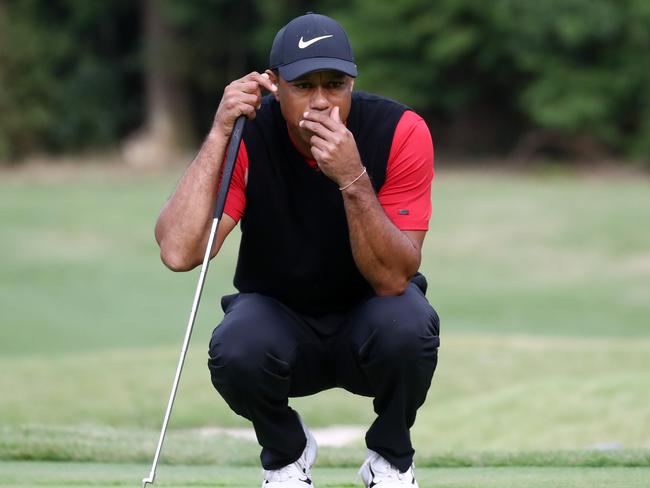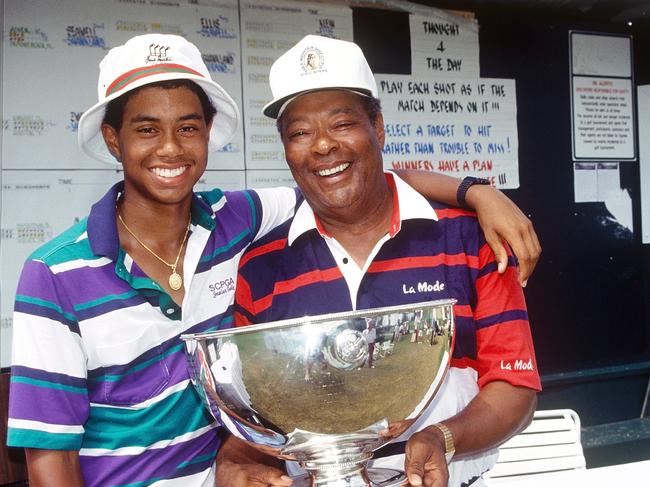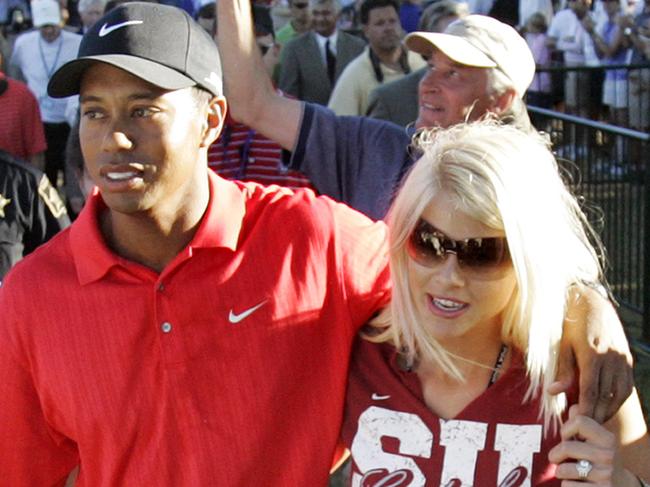New book reveals the inside details of Tiger Woods’ journey from child prodigy to golf icon
A new book charting the journey of Tiger Woods’ rise and fall has revealed he and his father weren’t always the easiest people to admire.
Golf
Don't miss out on the headlines from Golf. Followed categories will be added to My News.
Sports Illustrated writer John Garrity first met Tiger Woods when the golfer was just 16. At the time, the athlete had been playing a practice round at the 1992 LA Open and was excited about going for pizza and getting a new puppy.
Fifteen years later, Garrity was shocked by the person Woods had become, writes Curt Sampson in his book Roaring Back: The Rise and Fall of Tiger Woods (Diversion Books), out now.
“A pathological narcissist,” Garrity tells the author. “All of his human relationships were transactional. If you couldn’t help him achieve his goals, he had no use for you. He’d walk past and look right through you.”
A golf professional turned golf writer, Sampson is also the author of best-selling books on golfer Ben Hogan and The Masters. In Roaring Back, his 18th book, he charts the demise of Woods, beginning in 2009 as details of his multiple marital infidelities emerged, until his astonishing comeback at the Masters in April.
Early in his career, Sampson explains, Woods had gained a reputation as a cheapskate and a bad tipper. When he was an amateur, Woods and his father, the late Earl Woods, would travel from tournament to tournament, often staying at the houses of members of whichever golf club they were playing at rather than having to pay their way.
One such member was Dr. Al Oppenheim, whose Lake Merced County Club in San Francisco hosted Earl and Tiger in 1990 and 1992. “They assumed we’d buy them breakfast, lunch, dinner, and alcohol for Earl every day … which we did,” he tells Sampson. “But they were most unappreciative. They never once said thankyou.”
Woods’ excuse, according to Sampson, was that he never carries cash. “Narcissists don’t mind spending other people’s money because we’re in their debt already, and they find it hard to say ‘thank you’ for the same reason,” writes the author.

It’s perhaps one of the reasons Woods paid his coaches so poorly, too.
Hank Haney, who coached Woods from 2004-2010, was paid just $US50,000 a year, a sum that didn’t amount to much, given that Haney also had to pay for his own travel expenses and accommodation while on the road with his client.
This innate sense of superiority also extended to Woods’ life away from the golf course. In 2004, after a poor performance at the US Open, Woods told his then-caddie Steve Williams that he was through with golf and was intent on becoming a Navy SEAL, so confident was he of making the grade.
Three years later, Woods would even begin training with the special ops unit, taking part in hand combat drills, parachute jumps and diving exercises and becoming an expert with firearms. But when it was pointed out to him that SEAL recruits had to be between 17 and 28, Woods, then 31, dismissed it, telling his caddie that they would make a “special exemption” just for him, Williams later wrote in his own book, Out of the Rough.
Much of Woods’ behaviour can also be laid squarely at the feet of his father, Sampson claims. At Woods’ first press conference as a professional golfer in 1996, Earl said that his son “would do more than anyone in human history to change the course of humanity”.

Earl even said that he was “personally selected by God himself to nurture this young man”.
And how. When Tiger was just six months old, Earl would sit him in a high chair and make him watch as he hit golf balls into a practice net, suspended from the living room ceiling. Four months later, Tiger hit his first golf balls, left-handed, before deciding just a couple of weeks later that he preferred playing right-handed instead.
Driven on by his father, Woods soon became the hottest story in golf. At age three, he had a putting competition against comedian Bob Hope on the Mike Douglas Show and then appeared on ABC’s That’s Incredible. By the age of 11, he was beating his dad every time the pair teed it up and by 15 he was the youngest ever US Junior Amateur champion.
Earl, meanwhile, always brushed off his image as a controlling parent. “It was never a question of me forcing Tiger to play golf. Everything came from him,” he told Observer Sport Monthly magazine in 2002. “We transcended the father-son thing when he was five. We became best friends, equals.”
Not so, writes Sampson. “The father was the grandiose one, not the son, who was simply grand.”
Earl died from a heart attack in 2006 and, uncharacteristically, Tiger burst into tears on the final green when he won the Open Championship just weeks later at Royal Liverpool in the UK. It was Woods’ 11th major championship and Jack Nicklaus’ record of 18 major titles was now within his sights.

Everything was going to plan. On the course, Woods was breaking nearly every record in the book. Off the course, he was married to Elin Nordegren, a Swedish swimsuit model, had a young family and was well on his way to becoming his sport’s first-ever billionaire.
But everything changed on November 25, 2009, when the National Enquirer published a story alleging that Woods had had an extramarital affair with nightclub manager Rachel Uchitel. Two days later, Woods left his Florida mansion in his Cadillac Escalade at 2.30am and crashed the vehicle into a tree and a fire hydrant. Treated for facial lacerations, Woods emerged from the hospital and stumbled straight into a scandal that would all but ruin his life.
According to the National Enquirer, Woods confessed to having cheated with up to 120 women, including a 21-year-old neighbour, a woman he had known since she was 14.
The collapse of his marriage was one thing — Woods and his wife would be divorced within the year — but the collapse of his professional life was truly shocking.
He lost his form, his endorsement deals, his hair and, to all intents and purposes, a decade of his life.
As his myriad injuries caught up with him, his ranking plummeted to 68th in 2010, 128th in 2011 and an unfathomable 1999th in 2017.
“He fell from such a high place that he was halfway to earth before we mere mortals even recognised him as one of us,” writes Sampson.
Woods eventually recognised the error of his ways — he said he had felt he “deserved to enjoy all the temptations” around him — and leaned on his determination and focus to help rebuild his career.
Despite a crippling set of injuries that would have forced most players to call it a day, Woods returned to playing and slowly worked his way back to the big time.
On Sunday April 14, 2019, Woods appeared on the same Augusta National Golf Course where he had wowed the world as a 21-year-old in 1997, winning by a record margin. Nobody really thought he could win, not after everything he had been through.

But the man who had trained with Navy SEALS proved his superhuman abilities yet again. Two shots behind the leaders going into the final round, Woods pulled clear of Italy’s Francesco Molinari to land a fifth Green Jacket. Jubilant scenes greeted his triumph, 11 years since his last major victory.
Now with a new outlook and a new girlfriend, Erica Herman, Woods is said to have worked on himself as a person, too. Friends say he is more relaxed and reflective, more approachable. Even the legendary Nicklaus has noticed the difference.
“You can actually have a conversation with him,” he said during his own tournament, the Memorial, in June.
Meanwhile, Woods’ close friend, NBA legend Michael Jordan, said his redemption has been nothing short of miraculous.
“He’s probably the only person who believed he could get back,” Jordan told The Athleticin April. “To me, it’s unbelievable. To me, it was the greatest comeback I’ve ever seen.”
This article first appeared on the New York Post and was reproduced with permission
Originally published as New book reveals the inside details of Tiger Woods’ journey from child prodigy to golf icon
